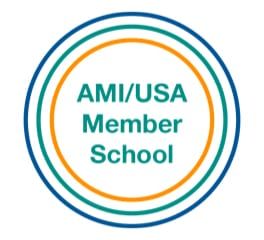Classroom Notes | March 2019
Ms. Hunt
Happy Spring! March was a month of changes…both in the classroom and outside! The children have noticed the warmer weather, return of green grass and even the accumulation of mud outside. We discussed Daylight Savings Time, the arrival of Spring and the lengthening amount of sunlight each day. We have been learning about different parts of living things, including the parts of a tree, and singing and signing the songs “My Roots Go Down”, “Spring is Here”, and “Robin in the Rain”. The children are especially enjoying our new poem “Every Time I Climb A Tree” by David McCord. It is the longest poem we have learned!
Some of the materials on our shelves have changed as well. In anticipation of Spring Break trips, many friends practiced packing a suitcase, an extension of our folding work. This simple Practical Life activity brings the children such joy and satisfaction and truly meets a practical need that the child will have in their day to day life. Stamping and marble rolling are two new art works that the children are also enjoying.
Mardi Gras is a holiday that was celebrated this year during the month of March, and we discussed the customs and geography of this festival. One of the children’s favorite books, “Trombone Shorty”, is set in New Orleans and chronicles the life of the musician Trey Andrews, as well as the musical traditions of this city. The children practiced being respectful audience members while listening to the music of Trombone Shorty and Bo Diddley, and later were able to move their bodies to these exciting rhythms.
Reading has exploded in the classroom over the past month! Many children are reading for the first time, and their enthusiasm is infectious! Some children are gaining confidence while exploring the different ways that some words are spelled (alternate spelling materials), some are exploring the different parts of language and sentences (function of words), and some are reading with confidence to small groups of their peers. This progression is an example of how beneficial the multi age classroom and three year cycle can be; younger children are inspired by the leadership and determination of the older children and seek them out for help. The older children gain social leadership skills and cement their own knowledge through supporting the younger. This is the perfect recipe for compassionate and respectful individuals working together in a harmonious community!
We have enjoyed having caregivers into observe the classroom this month, and appreciate your insightful observations and questions. We look forward to those that are yet to come!
Ms. Thome
With winter on it’s way out and the excitement of Spring and Spring Break bubbling we focused a lot on Grace and Courtesy in March! As Montessori teachers, we have all learned about the importance of the prepared environment, the meticulous way to present lessons, and the many other crucial aspects to offer children the best Montessori education. However, the more I teach and learn, the more I see that Grace and Courtesy lessons are so important to present all throughout the year. Yes our environment must be beautiful, our materials spotless, our assistant trained, and our plan ready, but without Grace and Courtesy all our hard work could be worthless.
Children starting around age 3 have a very sensitive period towards social interactions. Grace and Courtesy lessons not only meet that need but also offer children the tools they seek to be both i ndependent and successful in the classroom.
Group Grace and Courtesy Lesson
Grace and courtesy is an integral part of the Montessori curriculum beginning in the early childhood classroom and continuing through the elementary levels. In The Montessori Method, Dr. Maria Montessori stated, “Considering the method as a whole, we must begin our work by preparing the child for the forms of social life, and we must attract his attention to these forms” (121). Lessons which help children learn these social strategies are taught so they can navigate friendships and collaborations with others that can benefit them throughout their life.
How to help a friend in need
It is a general attitude of graciousness and respect. We can only create it when first we model it with our own actions, and then with good-natured lessons, we demonstrate the way we do things in our class, or in our home.
We want our children to be helpful. So how do we teach that? Be helpful, go out of your way to help a sick neighbor, friend or grandparent that needs some assistance.
We want our children to be respectful. How do we teach respect? Be respectful of your spouse, friends and of your children.
The only way our children learn to interact with others is by observing and modeling it.
Conveying the Same Message with Our Words & Actions.
As parents and as teachers, we quickly learn that we cannot say one thing and do another and expect the child to do what we say–children notice it immediately. Ultimately, our own awareness and our own efforts to live and treat each other better are what help our children learn.
Grace and Courtesy includes many things, from care of the self and care of the environment to learning the kind and gracious way to handle all manner of situations. We care for one another’s needs and we help one another learn new activities.
When we see our children not functioning the ways we wish, in many cases, we simply re-present the behavior that we want, without shame or blame. With these lessons we set the standard of how we want our classrooms and our homes to function. Develop the lessons you need for the layout of your home and the rituals you wish your children to follow.
Remember, in Montessori, we do not assume the children know something, we teach everything, giving the child the opportunity to practice the desired task mindfully and as often as they want to.
Ms. Crews
FOOD PREPARATION
This month, our community has been diving in to food preparation activities! Children have been bringing bananas and cucumbers to slice and eat during snack or lunch.
The mixed age dynamic has been alive as older children give lessons to younger children on slicing, cleaning up, and waiting patiently until the snack table is available.
A child’s healthy relationship with food and eating begins in infancy, and continues as they learn to enjoy the myriad of tastes and textures the world of food has to offer. Giving them independence around food empowers them and helps them feel connected to what they are eating.
When she slices her own banana or cucumber, a child is experiencing the shape, texture, and smell of the food she is about to enjoy before she even tastes it! Waiting to enjoy it also helps build delayed gratification and enhanced appreciation of a meal!
Slicing cucumbers with a wavy chopper and tongs ; enjoying cucumbers at the snack table.
SEWING AND TEXTILE ARTS
I have been enjoying learning about the fibershed movement and making rather than consuming. I’ve been delighted to share this with the children as they are ready to take their sewing skills to the next level. Sewing has been alive for the children of all ages in the community this month! We continue to practice learning to sew with a lacing hoop, burlap sewing, button sewing, and cross stitch. For those who have had much practice and are nearing the Second Plane of Development, there is now a tangible result of their hard work!
Sewing in our classroom has become a means of self-expression and extending the life of clothing. This month, children have embroidered their own drawings, sewn felt flower buttons they can pin to their clothing, stitched fabric amulets to wear as necklaces, and mended holes in their clothing.
Some of the oldest children have also begun knitting! This is a challenging way to employ partnership of the hands and concentration.
We strive to use re-purposed fabric scraps and donated yarn, all out of natural materials when possible. This has sparked all kinds of sensory opportunities for feeling and naming different natural textiles (linen, silk, flannel, burlap, wool) and discussing their origins and the idea of re-purposing. Since composting and recycling are part of our daily classroom routine, knowing what a material is made of is a natural part of a work cycle!
A younger child practices sewing on a lacing hoop; an older child
measures the cord on a fabric amulet he has stitched.
As the weather warms and the energy ramps up, I’ve been really enjoying this lovely reminder to practice self-care as adults. Happy Spring, everyone!
Ms. Schiller
At the end of each school day we gather and sing. After a few songs, I read aloud. It is a nice way to wind down and bring closure to our day.
Several weeks ago one of the children told me that she had a chapter book in mind that she wanted to read to the class. For the past many weeks she has been reading aloud each day to the rest of the class. It has been quite lovely. Her enthusiasm and character/vocal expression has been spot-on, and the listening children have been very engaged.
At the end of last week, she finished the book. The children applauded. She seemed so satisfied and empowered. The next day I picked up a new book and began reading again. The book we just began is “My Side of the Mountain” by Jean Craighead George.
As children grow and their reading abilities grow, I cannot express enough the importance of reading aloud to your children. With children who are just developing their reading skills, this is the best way to develop their ability to read for themselves and by themselves. Your reading aloud daily to your children allows them to become aware of the relationship between the printed word and speech as well as inviting them into the wide world of new and exciting language.
Once your child is reading independently, it is tempting to stop reading aloud. Please continue to read aloud to them routinely. Children continue to profit by your oral reading of language that is an increment beyond their reading level. This time together can strengthen your relationships, provide shared literary experiences, and allow for natural opportunities for vital discussions on values.
Another type of reading aloud that the children do in the classroom is reading/presenting their research/stories to the group. On Fridays we have time set aside in the afternoon for children to present their work. We have heard fascinating presentations on: Three Different Types of Rock and How They Form, Bats, Which Animals Have the Fastest/Slowest Heartbeats, Ticks, Beanie Boos, Grizzly Bears, Death-stalker Scorpions, Sea Turtles, and so many more. When the children read/present their work they have already practiced reading their work to a friend or two so they can find the flow/fluidity of their words when their read off of the page. They then read their presentation to the group. This is followed by applause and questions/comments from the audience.
As the children are practicing and growing in their presenting/read aloud skills, I strongly encourage you all to continue to work on your read aloud skills….and read, read, read to your children.
Ms. Arminio
Earth Day is an event observed annually on April 22. It is a day held to demonstrate and promote environmental awareness and the protection of our planet. Earth Day is celebrated in more than 193 countries each year. This year our class will celebrate Earth Day doing outside yard work in our garden. Enjoying lessons about our Earth and the fauna and flora. We will talk about recycling, and try our hands at making paper. We are working on an Earth Day Pledge:)
Lower Elementary Short Stories (our stories) will be published in April and we will have an Author’s Tea and Read Aloud. The May date TBA.
Organization makes for better writing. Before we write a report, we are encouraged to make a graphic organizer or complete a K now W ant to know L earned chart. The process keeps us focused on the theme, the important questions asked, and what we learn while we are reading, writing and sharing. The process helps with vocabulary and sentence structure and final composition.
We do Acts of Kindness when we share with a friend, when we speak to each other with respect, play using our manners, tell a joke, smile a someone, work together on a project, compliment someone, walk the dog, call a friend, say hello, read to a friend, wave, sing a song and the list goes on. The best part of kindness is that it comes naturally and we practice it moment-to-moment every day!!
Spelling Made Fun can be an easy way for children to practice. Take turns at home or in the car, write a story or letter, make up riddles, write giant chalk words, do crossword puzzles, or play Scrabble. Spelling, reading, writing and comprehension are closely linked; therefore, have fun frequently.
Grammar box
The post Classroom Notes | March 2019
appeared first on Fort Collins Montessori School.
The post Classroom Notes | March 2019 appeared first on Fort Collins Montessori School.

















